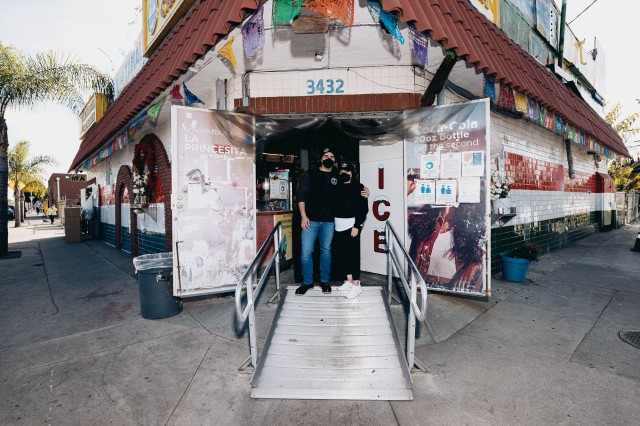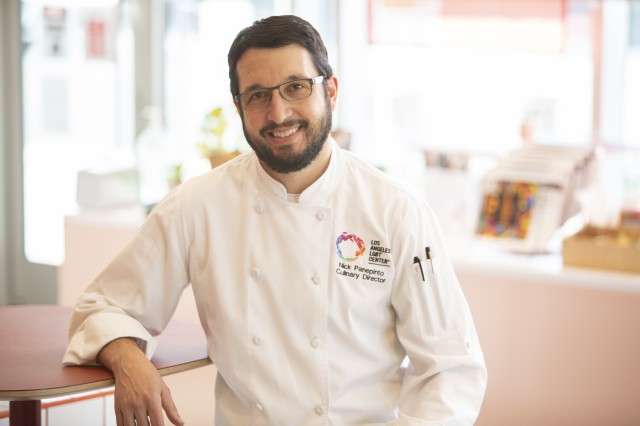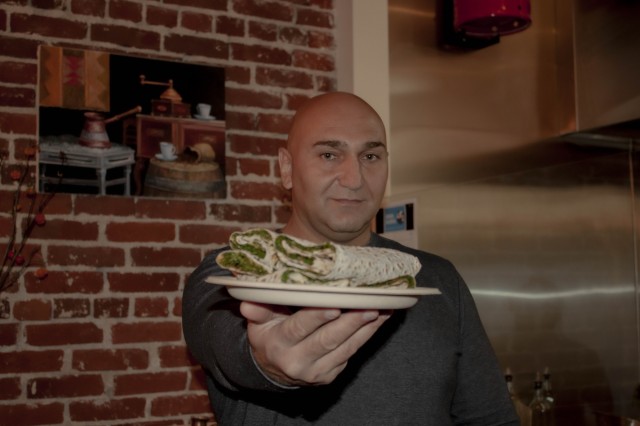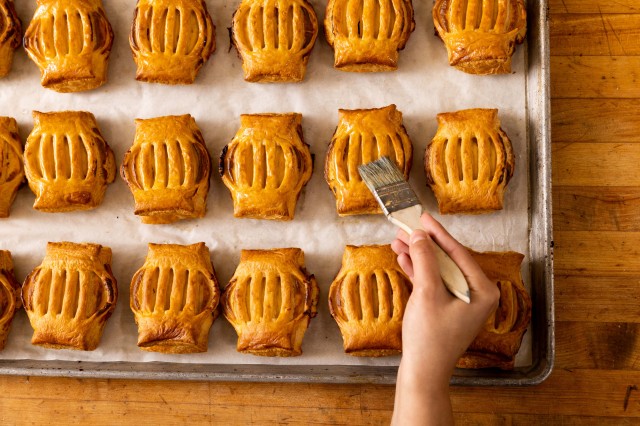
California’s Indigenous Food Future
Abe Sanchez | Chia Cafe Collective
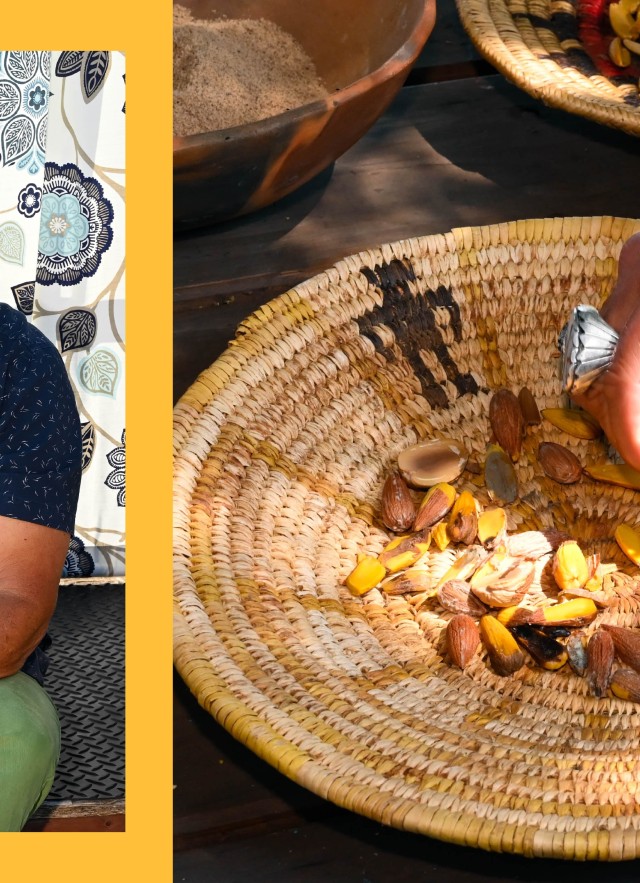
February 23, 2023
Kneaded: L.A. Bread Stories celebrates L.A. history, heritage, and communities through the lens of bread.
For most Native communities in the Southwest, acorns have been a dietary staple for thousands of years. Despite settler colonialism’s attempts to eliminate these traditional foods, members of the California Native community have been working together to reintroduce native plants to the menu. Individuals like Abe Sanchez (Purepecha) believe this traditional food that sustained the lives of his community in the past can become the food of the future for all Californians as we look for more drought-tolerant food solutions.
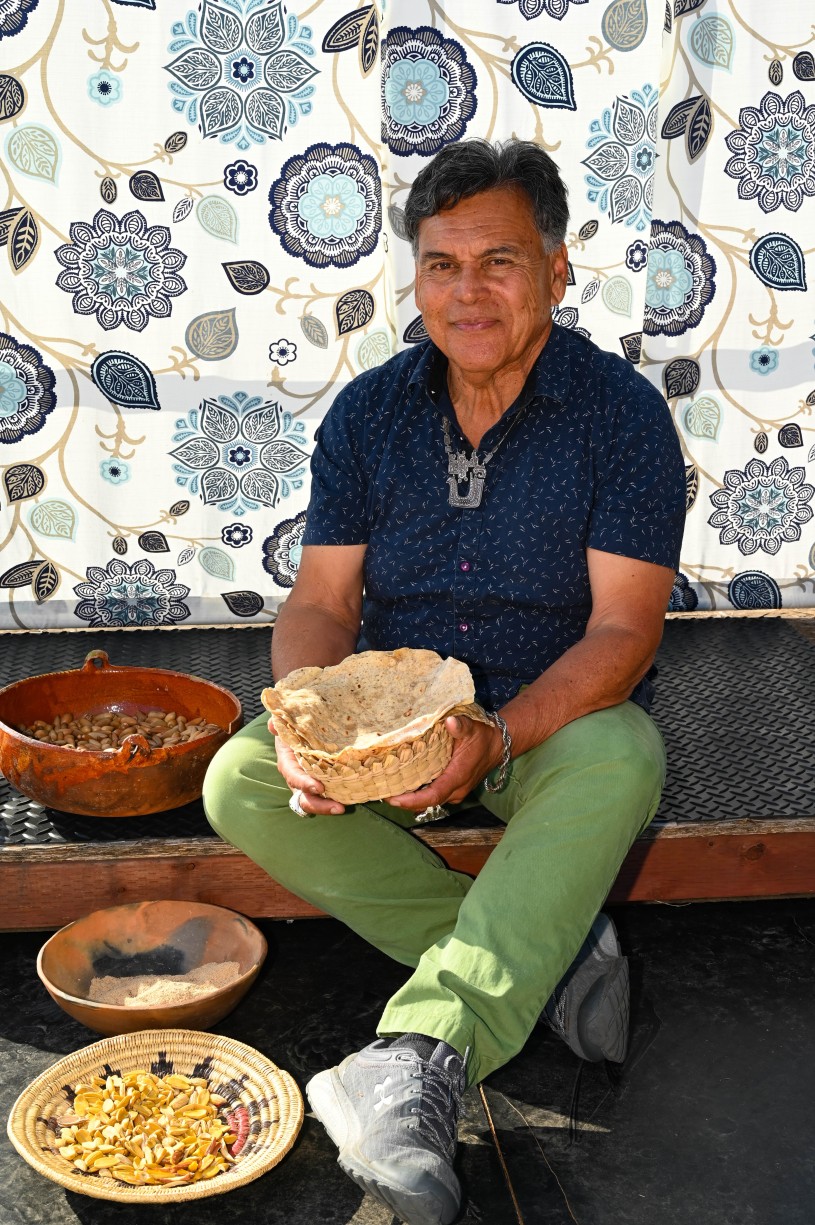
There is a lot of curiosity about eating acorns. Many people have heard that Native Americans eat acorns, but nobody really knows exactly how to do it. Due to colonization and assimilation, a lot of Native people have lost contact with traditional foods. I want to help people learn how to use it and cook with it in a way they will find enjoyable.
Abe Sanchez
Tell us about yourself and how you got started baking with acorns.
I am a part of an organization called the Chia Cafe Collective. It’s a grassroots organization aiming to reintroduce California native plants back into our diet. We want to help bring these traditional ingredients back into Native communities and share this knowledge with anyone else who is interested in the topic.
My particular interest in acorns is that it is a food source that has sustained Natives for many thousands of years, and I see acorns as a sustainable food source of the future. For the most part, acorns are pretty readily available. Oak trees are commonly planted in city parks and other places that are easy to access–you don't have to travel out of your way to find them. On top of that, California oak trees do not require an excessive amount of water to thrive. If enough people can learn how to process acorns and incorporate them into their diet, it will be better for us all and the environment.
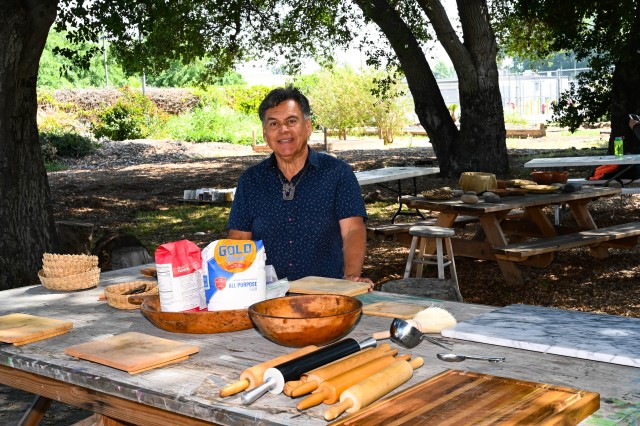
Abe sits ready to begin his hands-on acorn tortilla-making demonstration under the shade of several coast live oak trees.
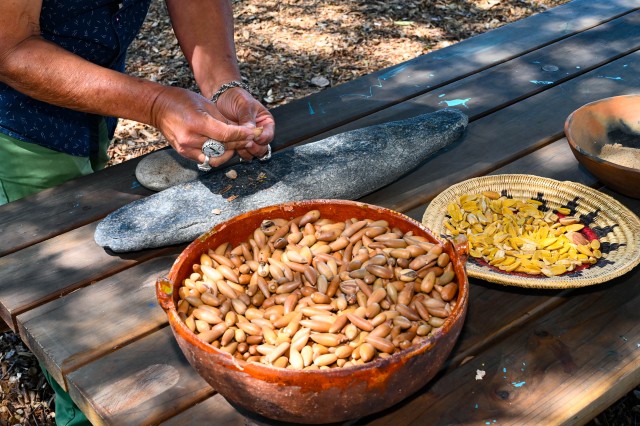
A bowl of coast live oak acorns sits next to a basket of freshly shelled acorn nuts, still yellow with tannic acid.
1 of 1
Abe sits ready to begin his hands-on acorn tortilla-making demonstration under the shade of several coast live oak trees.
A bowl of coast live oak acorns sits next to a basket of freshly shelled acorn nuts, still yellow with tannic acid.
What do you hope to teach people about incorporating acorn flour into their diet?
Acorns are an acquired taste; traditionally, they were eaten as gruel. While I personally like acorns this way, it may take a while for people to develop a palate for it. The goal for me is to get them to like how acorn tastes, so the Chia Cafe Collective’s approach is to mix native plant ingredients with other things that are more familiar to people. We put acorn flour in bread, into soups to thicken them, in traditional flour tortilla recipes, and so on. Reintroducing acorns in this way helps people gradually develop a liking for the flavor.
What do you love most about processing and cooking acorns?
The historical context of the use and processing of acorns is what I love the most. Acorns have been used for thousands of years in California and worldwide. It’s one thing knowing how the process was carried out in the past, but now I’m figuring out ways to continue this tradition in the present and future. Harvesting, processing, leaching, and cooking with acorns are very nuanced processes that have taken me years to figure out.
I've learned when it's best to wait and when it's good to gather acorns. I have also learned about storage–instead of storing them in glass or plastic, which can grow mold, I learned to store them in a dry place inside a breathable container like cardboard. I’ve also become comfortable leaching the tannins out in my sink–rather than in a sand pit outdoors like my ancestors used to do.
I now feel pretty comfortable processing acorns myself at home.
What are the steps of acorn processing?
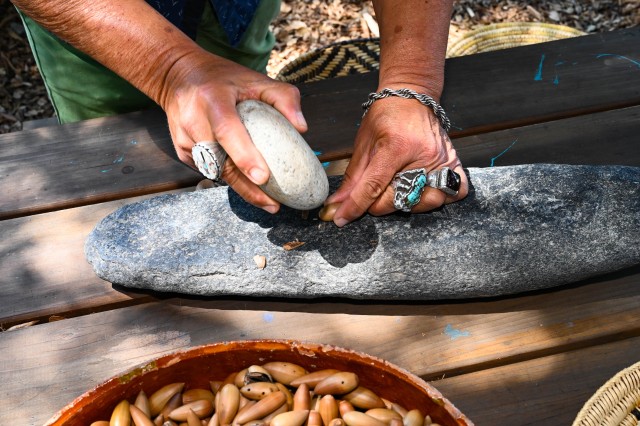
First, Abe strikes each acorn with a pestle, cracking its shell so the nut inside can be removed. After several have been shelled, they would be placed into a mortar and pounded into flour.
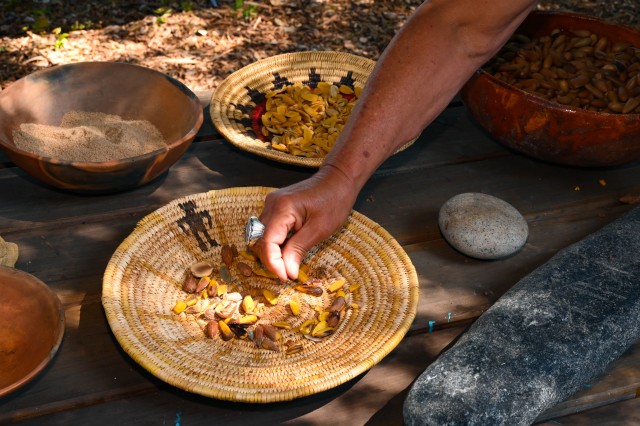
Notice how yellow the acorn nut is? That is because acorns contain a substance called tannic acid, which makes them taste bitter and could give you an upset stomach. Indigenous people found that with enough water, the tannic acid would leach out of the nut making it more palatable for human consumption.
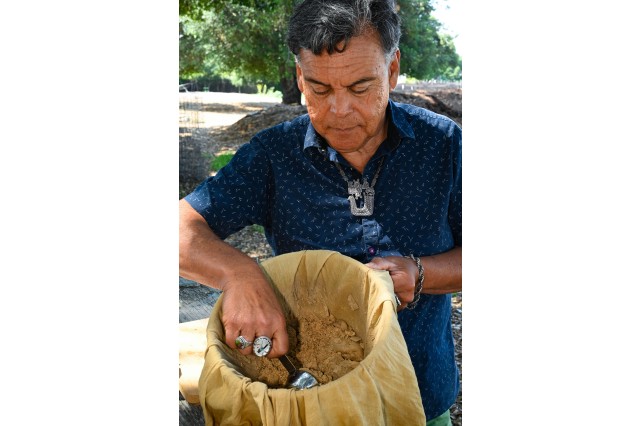
Abe leaches the acorn flour in nut-milk bags. The leached acorns are no longer yellow but instead a light brown color. This indicates that they have been leached enough to be ready to eat.
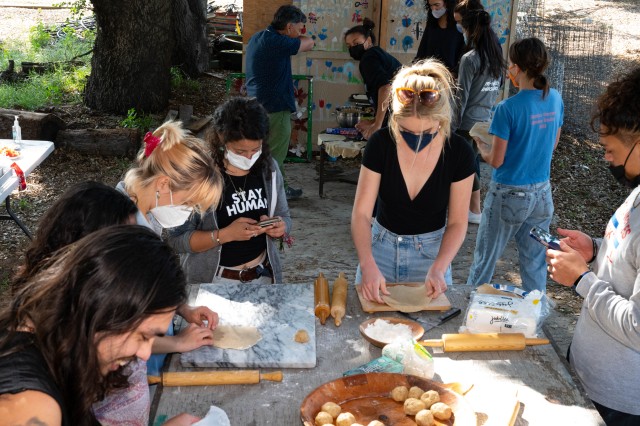
Abe combines wheat flour with acorn flour when making tortillas in this particular workshop. Wheat flour provides a familiar taste for students who are trying something new. Acorn flour can be used to make just about anything!
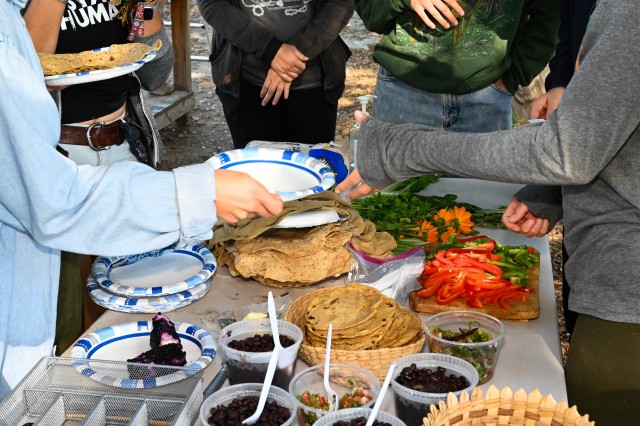
In step with other recipes in Chia Cafe Collective’s cookbook, Abe’s acorn tortillas are paired with ingredients we are all more accustomed to making tacos with today.
1 of 1
First, Abe strikes each acorn with a pestle, cracking its shell so the nut inside can be removed. After several have been shelled, they would be placed into a mortar and pounded into flour.
Notice how yellow the acorn nut is? That is because acorns contain a substance called tannic acid, which makes them taste bitter and could give you an upset stomach. Indigenous people found that with enough water, the tannic acid would leach out of the nut making it more palatable for human consumption.
Abe leaches the acorn flour in nut-milk bags. The leached acorns are no longer yellow but instead a light brown color. This indicates that they have been leached enough to be ready to eat.
Abe combines wheat flour with acorn flour when making tortillas in this particular workshop. Wheat flour provides a familiar taste for students who are trying something new. Acorn flour can be used to make just about anything!
In step with other recipes in Chia Cafe Collective’s cookbook, Abe’s acorn tortillas are paired with ingredients we are all more accustomed to making tacos with today.
How does acorn flour bring together the Native community?
Native people have always had a strong relationship with the plants, animals, and land we are Indigenous to. The things that people often refer to as natural resources today are a part of our community too. However, due to colonization and forced assimilation into western cultures, many people in our community have lost contact with these foods. Other members of the Chia Cafe Collective and I have spent so much time rebuilding our own relationships with these foods so that we can reintroduce them back to our people. While sharing this knowledge with our community, I also love seeing people's pride in these traditional foods. It especially brings me great joy to see so many young people wanting to learn to prepare and eat this food again.
Aside from the importance of keeping these traditions alive, I want Native people to eat their ancestral foods again because it is better for their health. For example, acorns have a low glycemic index making them good for people with diabetes to eat. Teaching our community these skills can have a real impact, and I am proud to be a part of this positive change. We need to get folks back in the kitchen!
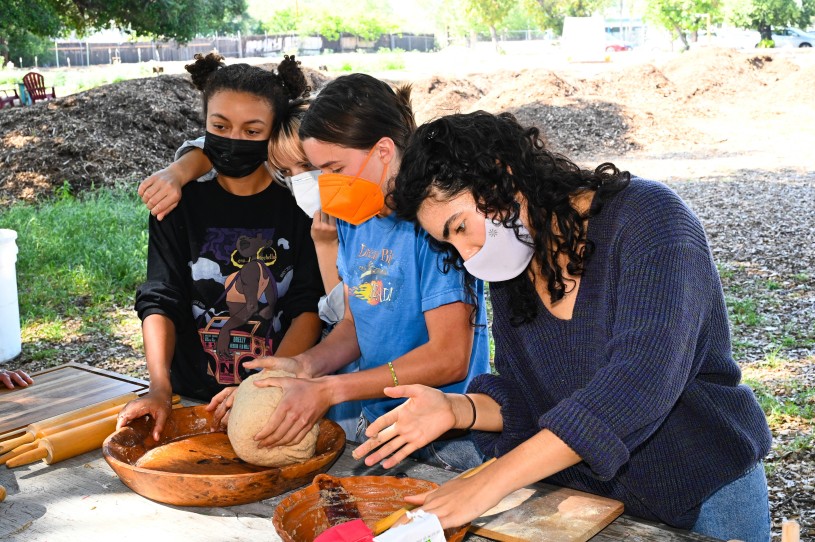
What does your work with the Chia Cafe Collective mean to you?
The community I have formed with the other members of the Chia Cafe Collective is very special to me. The process of relearning these traditions is both rewarding and challenging. It has been a lot of trial and error. We’ve had a lot of failures, but once we figure out those tiny glitches, we pass that information on so that others do not repeat our same mistakes. We want people to be successful, so they want to continue learning about processing and eating these foods.
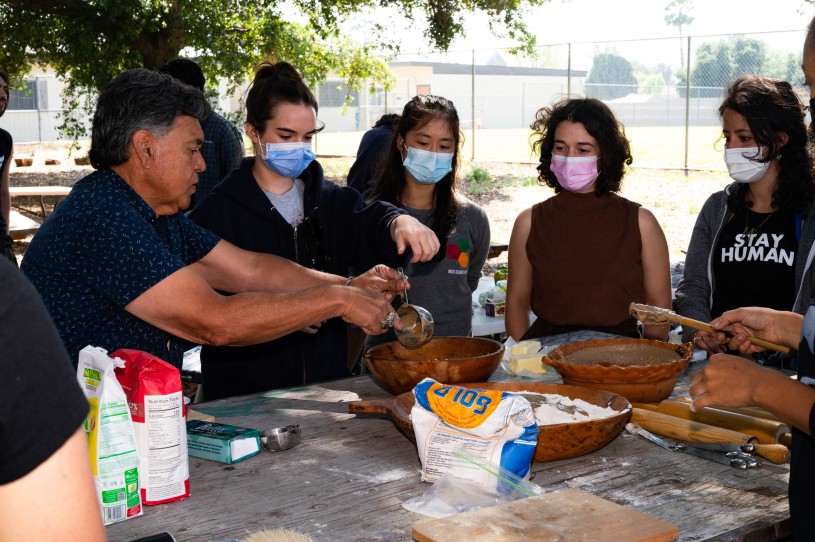
EXPLORE MORE FROM chia cafe collective
To see what’s cooking with the Chia Cafe Collective, visit their Facebook Page or look for their cookbook, Cooking the Native Way, at a store near you.
share your l.a. bread story
Do you know an L.A. breadmaker who lovingly connects to your community? Do you want to share your favorite experience with the Chia Cafe Collective? Join the conversation by tagging @NHMLA with #KneadedLA, and your story could be featured next!
Following the success of Kneaded: L.A. Bread Stories, we're celebrating the history, heritage, and communities of Los Angeles through the lens of different cultural traditions. This year, L.A. at Play highlights the vibrant and visionary work of artisans who fabricate dolls and figurines using a variety of techniques and materials.
